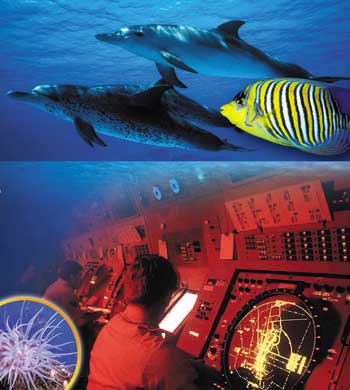 |
Great numbers of engineers and scientists employ advanced technologies in the manufacture of present-day submarines. Their aim is to produce machines that can stay longer underwater, with a greater capacity for movement with the expenditure of less energy. Yet despite all these studies and the bringing together of all their efforts, all they have achieved is a ship that can move forward underwater and rise and dive as required.
In addition, submarines must be made of very strong metals in order to resist the high pressures underwater. Inside, a large area has to be set aside for storing provisions and materials that let their passengers survive on the sea bed. Work is continuing, with intense efforts to resolve problems and improve the technology used in these ships. However, a great number and variety of creatures live beneath the sea. They, too, are exposed to pressure and must meet such needs as food and protection. Yet none of the difficulties that submarines must contend with constitute a problem for these creatures.
All marine creatures, from the tiniest fish to the largest whale, move around easily and use their superior maneuvering ability to swim and feed in the most productive manner. All species of fish have been designed to swim perfectly. Their fins have been specially located, and the shape of their tails, the size of their gills, and the protrusions and cavities in their skins all meet their needs in the best possible manner.
As you'll see in the pages that follow, the design in these living things is utterly flawless. The systems that let them resist pressure, feed, respire and defend themselves have existed in their bodies ever since these creatures first appeared. Any other possibility is out of the question, since these creatures would not be able to survive with partly functional, deficient "half-evolved" systems.
This proves that marine creatures appeared in a single instant, and fully formed. In other words, God created them all.
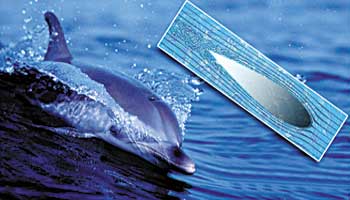 | 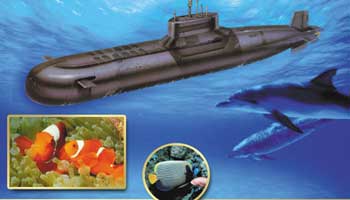 |
| God has created fish with a physical form that allows them to move through water with no difficulty. Their structure, oval at the front and resembling a pointed shuttle at the back, reduces the friction of the water to a minimum. Some fish, skates for example, possess a different shape that's equally ideal for moving through water. | |
 | The forces acting on a fish as it swims. The movement of its tail from left to right creates two forces, one acting in the same direction as the fish moves (A) and another to the side (B). Force A propels the fish forward. Force B influences the fish's turning. The resultant that emerges from these two forces (H) actually determines the direction and speed of movement. When the fish chooses to remain motionless in the water, it employs a force (K) to balance the forces from the water on its sides (S). |
Most machines produce power by means of shafts that revolve at varying speeds around their own axes. Animals also produce power, although their working systems are very different, in muscles entirely surrounded by blood vessels and nerves. Thus, they move thanks to structures far more complex and perfectly design than machines. Living things' power-creating engines are their muscles, capable of expanding and contracting like backward and forward-moving levers.
One example of these engines can be seen in marine creatures, most of whose movement takes place in a single plane. You can envisage that motion by imagining the way fish swim in water. The interconnected vertebrae in the fish's backbone constantly turns to right and left, so that in order to swim, all a fish needs to do is to wave its tail.
Under normal conditions, when the tail turns in one direction, the fish's head should move in the opposite direction, propelled with the same force. Yet that never happens, because fishes' bodies have been created in such a way as to eliminate that effect.
At the same time, the water acts on the head with a vertical force during movement. All this gives rise to the movement of the head part of the fish being smaller to that of the tail. It is this difference that allows the fish to move in the water.
How quickly the fish moves depend on how rapidly the axis passing through its backbone moves to right and left. The speed increases as the fin nears the axis, and decreases as it moves away.
 |  |  |
| Left: Fish seem to have very simple physical structures, but the fact is, the systems and mechanisms they employ to move in the water are the result of planning as sensitive as that of the latest model car. Right: A. Air sac | ||
How efficient is this system? When we compare a waving tail and a submarine engine, what kind of results emerge?
Professor Richard Bainbridge of Cambridge University and his team set out to answer these questions with observations from an underwater camera.
Their observations of a fish that was still and calm revealed that when alarmed, it went into action at an amazing speed.
From a standstill, a small freshwater fish can move forward 10 body lengths in the space of one second. A 20 cm (8 inch) fish can achieve a speed of 8 kilometers (4 miles) per hour. Speed increases with the size of the fish. Professor Bainbridge observed that a 32 cm (one foot) long fish achieved a sustained speed of 13 kilometers (6.5 miles) per hour.50 That speed is directly related to the frequency at which the fish moves its tail. The more it waves its tail in a short period of time, the greater the speed.
In swimming, fish expend large amounts of energy. However, sudden acceleration is vitally important to them, since fish need sudden bursts of speed for hunting and to escape from predators.
From a stationary position, some small fish can reach their maximum speeds in as little as 1/20th of a second. In that time, they can produce a propulsive force up to four times their own weight.
To fully understand the significance of these figures, consider that sports cars can accelerate from 0 to 100 kilometers per hour in between four and six seconds, and need a great deal longer to reach their maximum speeds.
Another point is that. Fish exhibit these superior performances underwater and in some species, even against the current. Since the resistance of water is greater than that of air, clearly that the fishes' performance is a most superior one.
The salmon is no doubt the best example in this regard.
As we've seen, salmon can lay their eggs only if they can return from the sea and reach the rivers where they were born. In order for salmon reach their birthplaces, they must constantly swim against the current of the river. They may have to overcome waterfalls in front of them, leaping four meters forward and two meters above the level of the water. To do so, salmon need to leave the water at a speed of 24 kilometers per hour (15 miles/hour). Falling after such a leap could be lethal for many creatures. Yet the salmon very seldom comes to any harm, and continues on its way. Did salmon's muscular and skeletal structures not permit them to make such leaps, they could not of course survive. (For detailed information, see Chapter 2: "The Salmon's Astonishing Direction Finding Systems.")
| Evolutionists claim that water-dwelling fish turned into land animals over tens of millions of years. Yet countless anatomical and physical factors make this impossible. For example, fishes' muscular and skeletal system can bear their weight in the water, but in order to survive after emerging onto dry land, they would need an entirely different structure. Land animals' metabolism can adapt to instant temperature changes. Since no sudden temperature changes occur under water, however, fish lack the necessary metabolism to cope with them. Animals living on dry land have a skin structure that reduces water loss—and thus, thirst—to a minimum. Creatures living in water, however, do not experience thirst, so their skins are not suited to waterless environments. |  |
| The kidney system of land-dwellers uses the minimum amount of water. But since water is abundant in the fishes' habitat, fish have no kidneys. So for the transition from sea to land to take place, fish would need to suddenly develop an advanced kidney system. Furthermore, fish take in the oxygen dissolved in water through their gills, and can't survive out of water for more than a few minutes. To survive on land, they would swiftly need to acquire a flawless lung system. It is impossible for all these features to form in a living thing by chance and in stages. In conclusion, it's scientifically and logically impossible for an aquatic creature to emerge onto dry land and adapt to it, in other words, to evolve. | |
As we know, fish are not restricted to moving forward and backward. A fish unable to move up and down will be unable to survive. This problem has been overcome with the air sacs created in fishes' bodies, thanks to which they can dive into the depths or rise up to the surface. When fish dive down to the bottom, the physical effects of the water on their bodies change. They adapt to changing conditions at various depths by reducing or increasing the gas in the air sacs.
In addition, fishes' centers of gravity are generally designed to pass through their air sacs, so if their balance is disrupted, they can regain their desired position by only small movements of their fins.
 |
| Thanks to their special sensory system, fish in schools can turn to left and right constantly without contacting any other fish. This sense in fish is so sensitive that they can even manage this in the pitch dark. |
Most fish are covered in a highly resistant skin, consisting of an upper and a lower layer. The upper layer contains glands secreting mucus, whose slipperynature reduces friction to a minimum during movement in the water. It also makes it more difficult for predators to seize them, and protects the fish from disease-causing organisms.51
Also, in the upper layer of fishes' skins is a keratin52-like layer that ensures no outside water enters the body. Were it not for that layer, the entry of water would impair the internal pressure balance in the fish's body , and the fish would die.53
The designs and functions of the several systems that facilitate the fish's movement through the water are all different. Yet in the absence of one, the others would serve no purpose, and any deficiency would mean death for the fish.
For instance, the mucus layer needs to have both specific levels of slipperiness and stickiness and also an anti-microbial property. It's of course a miracle that these conditions are achieved not in giant chemical factories, but in a layer just a few millimeters thick under the fish's skin. These features require the greatest wisdom, and are proofs that God has created fish. God reveals his omnipotence in a verse:
… everything in the heavens and Earth belongs to Him. Everything is obedient to Him, the Originator of the heavens and Earth. When He decides on something, He just says to it, 'Be!' and it is. (Surat al-Baqara: 116-117)
 | 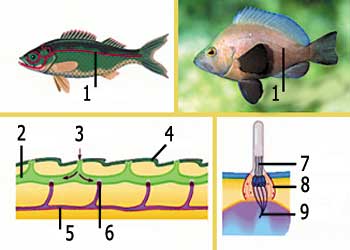 | ||
| 1. Lateral system | 4. Outer skin | 6. Nerve connection | 8. Sensory cells |
| Fish have been created with a perfect sensory system known as the lateral line. consisting of spots or broken lines extending along both sides of the fish. The system's sensory cells lie in a channel beneath the skin. | |||
Imagine that you are swimming along in a huge school of fish. If every individual in it wants to suddenly turn right or left—and what's more, in dim light or even darkness—will you be able to avoid bumping into the other fish? Definitely not!
Yet such movements, impossible for us, are perfectly simple for fish, because they have been created with a perfect sensory system known as the lateral line. This system consists of dots or lines along both sides of the body, containing sensory cells in a channel under the skin.54
The lateral lines immediately identify the slightest change in outside pressure, water movement, or strength or direction of the current. In contrast to the sensory systems of land animals, fish use the water's pressure waves and its feature of transportation and reservation of chemicals. Through these sensory systems, fish can half-feel and half-hear vibrations. Thus they can determine the presence of a predator or obstacle before they actually see it, can locate their prey or predators and find their way among the water currents. In particular, their lateral line lets them detect low frequencies nearby—footsteps on the shore or bodies falling into the water—and react accordingly.
By the water's edge, you can speak, sing or listen to the radio, and not alarm the fish. Yet if you do anything to set the water in motion—for instance, if you rock a jetty or throw a stone into the water—all the fish around will immediately flee.
Nearby objects reflect the vibrations reaching them. In this way, when a wave lands on the shore, the returning vibrations reach the fish's body in a short time. The lateral lines in the fish's body analyze these time frames and from these vibrations, the fish is able to establish an image of its surroundings. The fish can acquire more information by swimming faster or creating more vibrations of its own.
The system works so well that the fish can perform very detailed scanning. For example, the Mexican blind cave fish depends entirely on its lateral lines. Although it has no eyes, it can perceive objects no larger than a pinhead in the darkness of the cave it inhabits.55
In low visibility waters in particular, fish which swim in large schools in close proximity to one another use their lateral lines in order to detect rapid maneuvers.56
These sense organs possess a most complex structure. Of course, it's impossible for such a sensory system to come about gradually and in stages, through random coincidences. In order for the fish to survive, it's also essential that the system emerge all at once. This is yet another indication that fish did not come into existence by evolving, as evolutionists would have us believe, but that they were created by God, flawlessly and with no elements lacking.
 |  |
| Like many other fish, the splendid-looking beta (or Siamese) fighting fish uses its own waves to determine its surroundings. When threatened, the male warns its young by beating its fins to sets up waves. | |
The time when Emperor Penguins brood coincides with the polar winter. While the male penguins sit on the eggs, the females go off to find food for the chicks that will hatch. The distance between the nesting site and the nearest food source can sometimes exceed 100 kilometers. For roughly four months until her chick hatches, the mother penguin swims around and collects food in her craw. When she takes over the care of the new hatchling, the father penguin departs on a walk for hunting that can last for a very long time.57
The very surprising element in all this is that although penguins have fairly large bodies, their very short legs make walking difficult. Under normal conditions, this would lead to a considerable expense of energy. Penguins setting off on a long journey with only limited amounts of food should die of starvation.
So how is it, that in the face of such an apparent disadvantage, penguins can walk for many kilometers and reach the sea?
The answer reveals yet another miracle of creation.
Penguins walk by waddling from right to left, and back again. This pendulum-like gait allows penguins to save considerable quantities of energy. Penguins can overcome the disadvantage of exceedingly short legs by stepping sideways, thus tiring their muscles less. Indeed, at the end of every step they have meanwhile stored sufficient energy for the next one.58
Were they to walk straight instead of side to side, penguins would have to expend twice as much energy as any animal their size. Yet thanks to this special gait, the penguin expends energy only when beginning walking, and when stopping. And its limited amount of stored nourishment is enough for it to reach the sea.
Of course, a gait that conserves energy is not something the penguin could have discovered on its own. Moreover, this is something adopted by all penguins, not just one.
From the moment they are born, penguins know how to survive under the harsh conditions of winter. Any other behavior would have serious consequences, even death. It is out of the question for a penguin in the freezing cold to experiment with what it needs to do and finally decide to adopt this particular gait, which is yet another proof of God's love and compassion for living things. It is God Who creates penguins and inspires their behavior in them, Who has shaped all living things and created them together with all their incomparably perfect features.
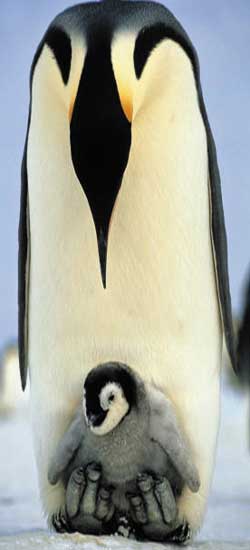 | 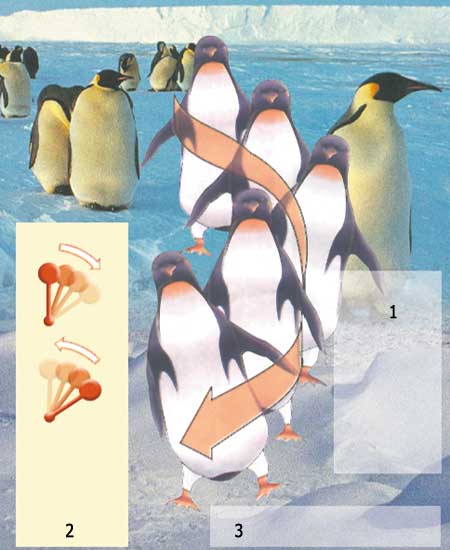 |
| 1. The penguin leans to the right, and when the potential kinetic energy it gains on stopping turns into movement again, then it leans to the left. 2. The penguin gait is similar to a pendulum. 3. It therefore expends energy only when beginning to walk and when it stops. | |
49. "Adhesive Force of a single gecko foot-hair", Kellar Autumn, Nature, June 8 ,2000.
50. "How Fishes Swim", Sir James Gray, August 1957, Animal Engineering, p. 30.
51. "Hircin Erkekleri, Bariscil Disileri ile Kemikli Baliklar" (Aggressive Males, Peacable Females and Boned Fish), Gülgün Akbaba, Bilim ve Teknik, October 1995, no. 335, p. 75.
52. Keratin: fibrous protein: a fibrous insoluble protein that is the main structural element in hair, nails, feathers, and hooves.
53. "Hircin Erkekleri, Bariscil Disileri ile Kemikli Baliklar" (Aggressive Males, Peacable Females and Boned Fish), p. 75.
54. John Downer, Supernature, p. 29.
55. Ibid., p. 32.
56. Ibid.
57. For more information: Harun Yahya, For Men of Understanding, Ta-Ha Publishers Ltd, January 2001.